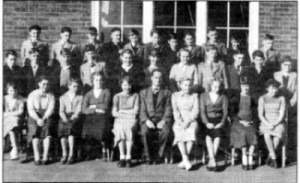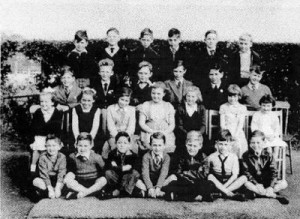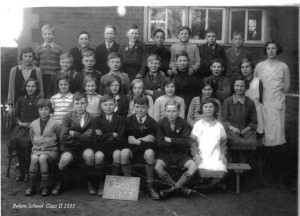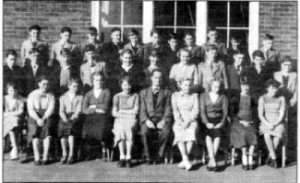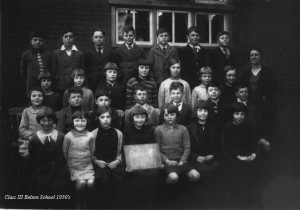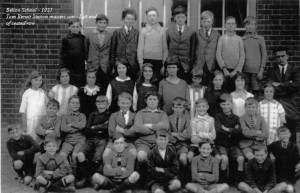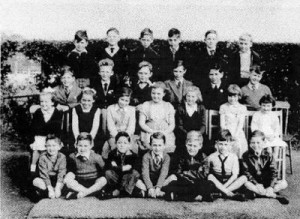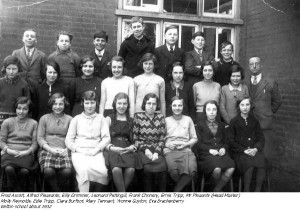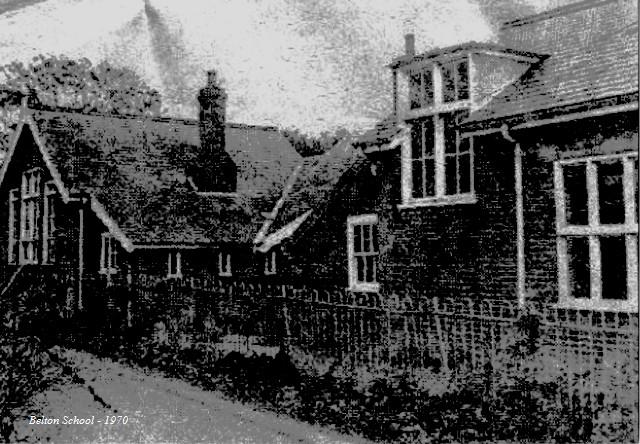

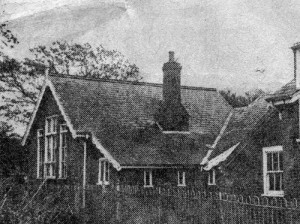
Belton School 1967
Teachers:
Mrs Cooke: A lovely teacher who rewarded good behaviour and enjoyed teaching.
Miss Meadows : Who married and became Mrs Hill – This was a stepping stone to a future career
Miss Storey: Also married and used Belton VCP as a stepping stone to a future career
Mrs Frost: A well meaning, well built opera singer, she had strict but old standards, always had a frown on her face, but still a good teacher.
The Caretaker
Mr Coleman:
Who lived next to the school, to the right hand side. He used to stoke the coke burning “pot – bellied” stoves which used to hear the classrooms in winter. Each stove was surrounded by a metal fire guard on which we could dry our rain soaked coat. It was also used to dry our wet shoes, socks, wellington boots, etc.
Mr Coleman would dress up as Father Christmas and give each child in the school a gift, usually a book and a handkerchief. He was generally thought to be quite stern & strict.
The Dinner-lady.
Mrs Doddington would dish up the food delivered from Bradwell, Mrs Doddington used to wash up all the cutlery & plates by hand.
Mrs Doddington was a lovely lady with a sweet heart.
Mr Ian Stone – Head master & upper class teacher.
An all round good – egg who would us go & play rounder’s on the Bell lane field almost every sunny day. He would read a story at the end of every day, we always enjoyed his class. The sports day & summer fetes were great fun.
The School
We had toilets outside, which had no plumbing, Mr Coleman used to empty the “chamber pots” inside every so often.
The coke for the stoves was kept on the upper school playground, tucked around the back and retained by a small wall.
We had “blackboard easels in every classroom, small sinks at the back. The cloakroom was small dark areas with small sinks, pegs & shoe racks between the upper & lower school rooms.
The main hall had a partition wall which could be opened through to the needlework room, for special occasions the parents could sit and watch the end of school plays, Christmas plays, such as “The Toy Shop”, umpteen Nativity plays, “The Tinder Box” Etc I remember.

Back row – from left – right
Mostly upper class – Mr Stone:
Stewart Leggett, Warick Dillon, Stephen Pendle, Tony Turner, Kim Saul, Kevin Martin, Gary Warner, Ronnie Spooner, Glenda Griffen, Avril Warner, Gillian Botwright.
Middle row From left – right:
Carol (unknown), Anita Baker, Jean Calver, Irene Manell, Angela (unknown), Valerie Spooner, Lillian Spooner, Barbara Thacker, Linda Cooper, Alexis Lawn,.
Third row from left – right:
Lower School mostly Mrs Frost:
Cheryl Barnes, Pamela chilvers, Stephen Thacker, Paul turner, Paul Pendle, Jackie Martin, Karen Pendle, Jill Thacker, Tina Cribb, Colin Barber, Frances Keyes, Elizebeth Botwright.
Front row from left – right:
Adrian Blyth, Gillian Kemp, Sharon Chilvers, susan Botwright, Kenny Spooner
This is from the memories of Karen Watkins (nee Pendle)
Formally of Belton
From the memories of David Tennant
I was born on August 28th 1935 so it was likely that I started school in September 1940. My memories of this event are non existent. My mother may have accompanied me on my first day or I may have been “delivered” by my older sister. Before this date I cannot recall any knowledge of Belton much beyond Sandy Lane where I lived. I expect that in the previous five years I had ventured beyond there with my parents but the journey to the school and its surrounding area was like visiting a new world. That there was somewhere called Stepshort was like Columbus discovering America! I suspect I was not alone in this as we were not so mobile in those days. The only accessory taken was a gas mask. These had been issued earlier at the Railway Tavern Tea Room and were carried in the supplied cardboard box about 6 or 8 inches (15 to 20cms) square and with usually the addition of a string loop for putting it over the shoulder. There was quite a cottage industry producing a more weather tight carrier for the gas masks ranging from cloth to the more upmarket versions in “leatherette”.
The Headmaster at that time was William Pitt Pleasants (known to one and all (pupils excepted!) as Pitt) The only other teachers I can recall from those early days were a Miss Grimble and, of course, the infant teacher Miss Martin (always known as Dolly) who later became Mrs Ward. I am sure there was at least one other. Miss Martin had a large upright bicycle with the usual arrangement at time of a network of strings running from the rear mudguard to the rear hub which was supposed to keep the ladies skirts from catching in the spokes. On leaving in the afternoon a large contingent of the infant’s class would follow her like sheep as she slowly rode her bicycle down Church Lane. We must have liked her!
I expect the school layout at that time is already familiar to many. Suffice to say that the Infant’s classroom was on the North end of the building nearest the Walk (the footpath from Bell Lane to St John’s Road at the King’s Head) and one progressed clockwise through the building eventually reaching the senior classroom adjacent to the School House. Remember at that time the School age range was 5 -14 years. I recall the youngest were seated on the right hand side of the room and (furthest from the coal fire) and our initial writing instruction was on a small blackboard and a piece of chalk. We later graduated to writing on paper, eventually in ink dispensed from a stoneware bottle into inkwells on each desk. A “dipper” pen was used and blots were many and frequent.
The coal fires in each classroom were the only source of heating. The teacher’s desk was closest to the fire. The cloakrooms had no heating at all, and I suspect if you arrived in wet outer ware it was still much the same when you put it on again to return home. There was also had no running water and, I could be wrong here, but I think the nearest source was the well at the adjacent School House. I will not comment on the sanitary arrangements! They were the standard rural arrangements existing at that time. I also cannot remember if there was an electricity supply. I think not. During war time, with double summertime all year, there was always sufficient daylight for classes.
At this time too the school was a Church of England School. Not too sure of fully what this entailed. Hymns and prayers each morning of course, sung grace at lunch time and “Now the day is over” sung before leaving in the evening. I think the words to the hymns were memorised. I cannot recall any written versions being distributed and, in fact, the convoluted wording of many of the “Hymns, Ancient and Modern” would likely be beyond the reading skills of the younger children. I remember a somewhat limited repertoire; “O God our help in ages past” was in the top ten. We also had visits from the Rev Hamilton who usually left copies of the “Wide World” magazine and a couple of collecting boxes for the British Empire Leprosy Relief Association (BELRA) which, I suspect, did not attract too much in the way of contributions. Pocket money for most was unknown.
And so it progressed. To and from School each morning and evening in the company of others from Sandy Lane. I remember Kenny Gray and Ralph Middleton in particular who were a little older than me. The route varied; sometimes up Church Lane sometimes via the Free (the footbath from the rear of the Rectory on Station Road across Ernie Morse and Ernie Guyton’s land to Bell Lane) No body as I recall cycled. One early memory was when a snow storm which filled Church Lane to bank level and the local County Council roadman, Mr Samson (a small man despite his name) had to dig, by hand, a walkway from the Church almost down to the White House. I suspect there was at least 3 feet of snow in the lane, maybe more
When I was at the School, two names I remember were Ella and Shirley Muir. These girls had been evacuated from Dagenham at the beginning of the war and were billeted with Mrs Davy on Station Road. I think there may have been others before I started but I understand that many of these early evacuees returned home when the bombing of London did not start as early as many thought it would. Mrs Davy ran a Concert Troupe for girls who put on shows at the Institute to raise funds for the war effort and other causes. Shirley and Ella were among the members of this troupe and were, as I recall, a formidable song and dance team.
In 1943 or 44, when the V1 flying bomb raids on London began, Belton received another, larger, batch of evacuees, this time from West Ham. I recall Bill Andrews and his younger brother who were billeted with Ralph Middleton’s parents in Sandy Lane and became members of the group to and from School.
With the evacuees came a teacher, Miss Hall, younger and, to my young inexperienced eyes, very glamorous. She lodged at the King’s Head. She was like a breath of fresh air and brought forth many a giggle when she removed and replaced her handkerchief in her knickers (to use the then terminology) leg. She was the subject of much attention by more than one US soldier who at this time were stationed on Fritton Common. Her current beau would often be waiting for her at the end of afternoon school and it would usually take chocolate and chewing gum aplenty to get rid of us kids. I well remember her asking me to go over to the Church and pick up a hassock to raise the level of her chair when she played the piano. I understand that, after she returned to London, she was sadly killed in a car crash.
At all times attendance was a high priority. There were regular visits by the school attendance officer, a Mr Carter, who would arrive periodically at school on a motorcycle, usually wearing a long , ankle length, brown overcoat and would the inspect the attendance registers. (The register was called twice daily) He would if necessary then, I understand, pay visits to parents who were suspected of not exercising enough diligence in sending their children to school. I do not know how frequently this was necessary. At this time also, the usual “childhood diseases” (measles, chicken box and whooping cough) would decimate the school attendance numbers. It usually swept through each class and household.
At about this time, Mr Pleasants had retired and he was replaced by Mr John Larter as Headmaster and his wife Iris (though we did not know her name at the time) as another teacher. Miss Grimble had by this time also retired.
Mr Larter brought changes. He negotiated with the King’s Head to use the Drill Hall for Physical Education and also with Mr Guyton for the use of his field, assuming the horse was not there, for other sports activities. It was the job of a pupil, sometimes me, to go out and check to see if the horse was there. If it had gone then the games could commence: football for the boys and rounder’s for the girls. No goalposts of course (a couple of coats) and everybody played in the clothing they came to school in. Additional hazards were the unevenness of the field and the abundant horse droppings! The School Garden, which at that time was beside the railway line at the Bell Lane Bridge, also saw resurgence. I understand that later it was moved closer to the school.
The war also saw the introduction of the “School Dinner” in addition to the daily milk, which was delivered by Long’s dairies from Gorleston in 1/3 pint bottles each morning. The dinners were delivered in large, very heavy insulated containers (I think they were called hay boxes). Where they were prepared and cooked I know not. They arrived at around 11 am and deposited just inside one of the school gates. It was the job of the boys to carry these into the school and they were then eaten in the senior class room , the desks serving as tables, and the used plates and cutlery were then taken over to the School House to be washed and dried ( I think by the caretaker and his wife)
There was also on a few occasions an issue of drinking chocolate, I think this came from the USA. We had to bring a jam jar or something similar to carry it home in. Not much survived the journey in most cases. It was surprising how much chocolate powder could be transferred from jar to mouth using a wet finger! This at the time was sheer bliss as everything was rationed including sweets and chocolate (not that we had any money to buy them if it had been able!)
Also at this time the dreaded “11 Plus” was in place but known at that time as the “scholarship” On reflection I, and many others, think that it was not a true test of academic ability. Mainly an attempt to measure IQ which experience has shown is not a measure of overall ability. I recall tests of the kind to identify the next number in a sequence and others relating to various shapes. There was also a project to be carried out. Mine was on Railways and there was also an interview I, together with Dorothy Addy, was successful in the summer of 1946 and we both started at the Sir John Leman School in Beccles in September of that year. My schooldays at Belton were at an end and for the next 5 years, decked out in cap and blazer; it was the 8.19 am train from Belton Station to Beccles returning home just before 5 in the evening.
From the memories of David Tennant
Does anybody else have memories of their time at the village school? If so please contact us

